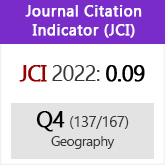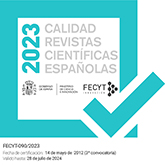The Landscape in French Literature since the Nineteenth Century and its relationship with painting
DOI:
https://doi.org/10.3989/estgeogr.201018Keywords:
french literature, landscape painting, XIX, XX and XXI centuries, landscape, urban landscapeAbstract
This article explores the values of landscape as seen in French literature since the nineteenth century and its connexion with painting in the same period. Both, the rural landscape presented by British and German artists and urban landscapes that radically changed since the industrial revolution, offer symbolic and social dimensions that are projected on to the literary and artistic fields. Nineteenth century French society experimented great political and sociological changes that had repercussions in literature from the Renaissance to post-modern rethinks. The nineteenth century is the greatest period of French literature, the most relevant writers, Chateaubriand, Stendhal, Hugo, Balzac spent time in the contemplation of the landscape and created new relationships and correspondences with nature. The recovery of spaces and their polisemy also applies to the whole of the twentieth century and the current period. Poets, writers and painters continue to integrate the landscape in their creations. As Fernand Braudel once said, landscapes and spaces are not only realities of the present time but also and above all, survivors of the past; «la terre est, comme notre peau, condamnée à conserver la trace des blessures anciennes».
Downloads
References
Auerbach, E. (1968; 19461): Mimésis, la représentation de la réalité dans la littérature occidentale. París, Gallimard.
Augé, M. (1998; 19971): “La ciudad entre lo imaginario y la ficción”, en El viaje imposible. El turismo y sus imágenes. Barcelona, Gedisa, pp. 109-131.
Balzac, H. de (1976): Ferragus, en La Comédie Humaine, t. V. Paris, Gallimard “Collection de la Pléiade”.
Balzac, H. de (2002): Ferragus. Barcelona, Minúscula.
Balzac, H. de (2006): Voyage de Paris à Java. París-Arles, Actes Sud.
Barthes, R. (1980): La chambre Claire. Paris, Gallimard-Cahiers du cinéma-Seuil.
Bonstetten, C. V. de (1992): L’homme du Midi et l’homme du Nord. Lausana, Editions de l’Aire.
Brunet, F. (2000): La naissance de l’idée de photographie. Paris.
Camus, A. (1954): L’Eté. París, Gallimard, “Les essais LXVIII”.
Carus, C. G. (1992): Cartas y anotaciones sobre la pintura de paisaje. Madrid, Visor.
Chateaubriand, F.-R. de (1947): Journal de Jérusalem, en Les cahiers Chateaubriand. Paris, Gallimard.
Chateaubriand, F.-R. de (1977): “Lettre sur l’art du dessin dans les paysages”, en Correspondance Générale (1789-1827), Paris, Gallimard, “Collection de la Pléiade”, t. I.
Chateaubriand, F.-R. de (1978): René, en Atala - René - Les Aventures du dernier Abencerage. París, Gallimard “Collection Folio Classique”.
Chateaubriand, F.-R. de (1997): Mémoires d’Outre-Tombe, 2 t. París, Gallimard, “Collection Quarto”.
Clair, J. (1989): Méduse. París, Gallimard.
Constant, B. (1809): “Réflexions sur Wallstein”, en Wallstein, tragédie en cinq actes et en vers, précédée de Quelques réflexions sur le théâtre allemand et suivie de Notes historiques. París-Ginebra, J.-J. Paschoud.
De Diego, R. (1997): Les villes de la mémoire. Québec, Humanitas.
Gombrich, E. (1989): Historia del arte. Madrid, Alianza.
Gracq, J. (1980): En lisant, en écrivant. París, José Corti.
Gracq, J. (1992): Carnets du grand chemin. París, José Corti.
Jacottet, P. (1984): La Semaison. París,Gallimard.
Legen, B. (2002): “Madame de Staël en la encrucijada de las literaturas del Norte y del Sur”, en José Enrique Martínez Fernández (coord.): Estudios de literatura comparada: norte y sur, la sátira, transferencia y recepción de géneros y formas textuales. León, Servicio de Publicaciones de la Universidad de León, pp. 171-182.
Legen, B. (1996): “Relaciones entre el paisaje y el personaje en la novela del siglo XIX”, en Actas del X Simposio de la Sociedad Española de Literatura General y Comparada. Santiago de Compostela, Universidad de Santiago de Compostela, pp. 359-366.
Paz, O. (1990): “The Nobel Prize in Literature 1990”. Nobelprize.org. <http://nobelprize.org/nobel_prizes/literature/laureates/1990> [25 Oct 2010].
Pollock, J. (1947-1948): “My Painting”, en Possibilities, 1, pp. 78-83.
Saint-Lambert, J.-F. (1782): “Discours Préliminaire”, en Les Saisons. Ámsterdam, p. XXII.
Simon, C. (1981): Les Géorgiques. París, Éditions de Minuit, 1981.
Staël-Holstein, G. (1836): De l’Allemagne, en Oeuvres complètes. París, Didot-Treuttel-Wurtz, vol. 2.
Stendhal (1965): La Chartreuse de Parme. Paris, GF-Flammarion, “Livre de Poche”.
Strick, J. (1986): “Connaissance, classification et sympathie, les tours de paysage et la peinture de paysage au XIX º siècle”, Littérature, 61, pp. 17-33.
Sue, E. (1869): Le juif errant. París, Lacroix-Verboeckhoven.
Thibaudet, A. (2007): “Le roman Urbain”, en Réflexions sur la littérature. París Gallimard, “Collection Quarto”.
Downloads
Published
How to Cite
Issue
Section
License
Copyright (c) 2010 Consejo Superior de Investigaciones Científicas (CSIC)

This work is licensed under a Creative Commons Attribution 4.0 International License.
© CSIC. Manuscripts published in both the printed and online versions of this Journal are the property of Consejo Superior de Investigaciones Científicas, and quoting this source is a requirement for any partial or full reproduction.All contents of this electronic edition, except where otherwise noted, are distributed under a “Creative Commons Attribution 4.0 International” (CC BY 4.0) License. You may read here the basic information and the legal text of the license. The indication of the CC BY 4.0 License must be expressly stated in this way when necessary.
Self-archiving in repositories, personal webpages or similar, of any version other than the published by the Editor, is not allowed.
















